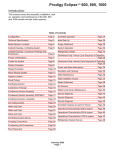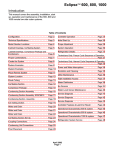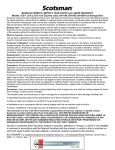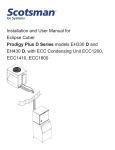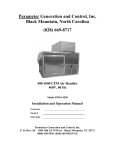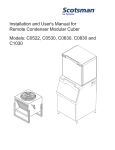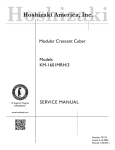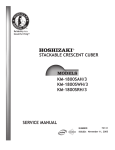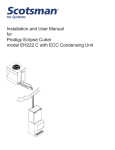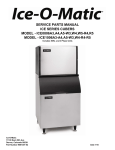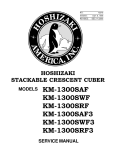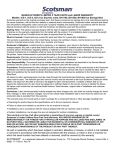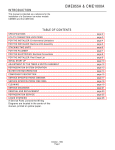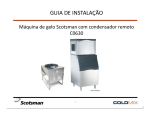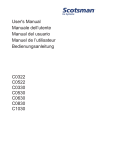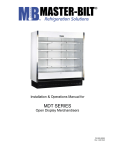Download Prodigy Eclipseä 1200, 1400, 1800, 2000
Transcript
Prodigy Eclipseä 1200, 1400, 1800, 2000 Introduction: This manual covers the assembly, installation, start up, operation and maintenance of the 1200, 1400, 1800 and 2000 remote low side cuber systems. Table of Contents Configuration· · · · · · · · · · · · · · · · · · Page 2 Initial Start Up · · · · · · · · · · · · · · · · · Page 26 Technical Specifications · · · · · · · · · · · · Page 3 Ice Bridge and Water Purge Adjustments · · · Page 27 Model Number Locations · · · · · · · · · · · Page 4 Controller Information · · · · · · · · · · · · · Page 28 Cabinet Drawings, Ice Making System · · · · Page 5 Use and Operation· · · · · · · · · · · · · · · Page 29 Cabinet Drawings, Compressor Package and Condensers · · · · · · · · · · · · · · · · · · Page 6 Control Switches · · · · · · · · · · · · · · · · Page 30 Proper Combinations: · · · · · · · · · · · · · Page 7 Create the System · · · · · · · · · · · · · · · Page 8 System Examples · · · · · · · · · · · · · · · Page 9 System Examples · · · · · · · · · · · · · · · Page 10 Place Remote System · · · · · · · · · · · · · Page 11 System Location · · · · · · · · · · · · · · · · Page 12 Route Tubing· · · · · · · · · · · · · · · · · · Page 13 Ice Making Section· · · · · · · · · · · · · · · Page 14 Compressor Package · · · · · · · · · · · · · Page 15 Condensing Section Assembly · · · · · · · · Page 16 Condensing Section Assembly · · · · · · · · Page 17 Ice making section: · · · · · · · · · · · · · · Page 18 Water and Drain · · · · · · · · · · · · · · · · Page 19 Water and Drain · · · · · · · · · · · · · · · · Page 20 Ice Making Section Set Up · · · · · · · · · · Page 21 Coupling Connections:· · · · · · · · · · · · · Page 22 Condensing Unit Connections · · · · · · · · · Page 23 Options· · · · · · · · · · · · · · · · · · · · · Page 31 System Operation: · · · · · · · · · · · · · · · Page 32 Refrigeration Details: · · · · · · · · · · · · · Page 33 Technicians Only: Freeze Cycle Sequence of Operation Page 34 Technicians Only: Harvest Cycle Sequence of Operation · · · · · · · · · · · · · · · · · · · Page 35 Control Safeties · · · · · · · · · · · · · · · · Page 36 Controller Operation · · · · · · · · · · · · · · Page 37 Cleaning, Sanitation and Maintenance · · · · Page 38 Service Diagnosis · · · · · · · · · · · · · · · Page 40 Service Diagnosis · · · · · · · · · · · · · · · Page 41 Service Diagnosis · · · · · · · · · · · · · · · Page 42 Operational Characteristics 1200 lb system · · Page 43 Operational Characteristics 1400 lb system · · Page 44 Operational Characteristics 1800 lb system · · Page 45 Operational Characteristics 2000 lb system · · Page 46 Refrigeration System Service · · · · · · · · · Page 47 Final Placement · · · · · · · · · · · · · · · · Page 24 Controller Operation · · · · · · · · · · · · · · Page 25 Keep this manual for future reference. Note this symbol when it appears. It indicates a potential hazard. August 2008 Page 1 Prodigy Eclipseä 1200, 1400, 1800, 2000 Configuration A remote low side cuber system includes several sub systems: an ice making section, a remote compressor package, and a remote air cooled condenser. Additionally, there are several models of each sub-system and this manual covers all of them. Do Not operate the machine in conditions beyond these limitations. Doing so will void the warranty. The ice making sections are designed for use indoors in a controlled environment. The remote compressor packages and condensers are designed to operate outdoors. Each sub-system has limits for power, water and temperature. Scotsman assumes no liability of responsibility of any kind for products manufactured by Scotsman that have been altered in any way, including the use of any part and/or other components not specifically approved by Scotsman. Operational Limitations: Scotsman reserves the right to make design changes and/or improvements at any time. Scotsman ice systems are designed and manufactured with the highest regard for safety and performance. They meet or exceed the standards of UL and NSF. Minimum Maximum Air Temp (IMS) 50oF 100oF. Specifications and design are subject to change without notice. Air Temp (CU) -20oF. 120oF. Warranty Water Temp o o 40 F. 100 F. Water Pressure 20 psi 80 psi Voltage (IMS) 104 126 Voltage (CU) 198 253 Refer to the warranty coverage in effect when the equipment was sold. Warranty statements are included with each product. Systems: IMS = Ice Making Section, CU= Condensing Unit System Information Each sub-system is a separate entity that carries its own model and serial number. They must be combined to create a remote cuber low side system. Condensing Unit (CU) Prodigy Eclipse System Size Compressor Package Model Electrical 1200 C1200CP-32A 208-230/60/1 1200 C1200CP-3A 1400 C1410CP-32A 208-230/60/1 1400 C1410CP-3A 1800 C1800CP-32A 208-230/60/1 1800 C1800CP-3A 2000 C2000CP-32A 208-230/60/1 2000 C2000CP-3A 208-230/60/3 208-230/60/3 208-230/60/3 Condenser Model Electrical Model ERC1086-32A 208-230/60/1 EH330SL-1A or EH330ML-1A Electrical 115/60/1 ERC1086 -32A 208-230/60/1 ERC2086-32A 208-230/60/1 EH430SL-1A or EH430ML-1A 115/60/1 208-230/60/3 Notes: Voltage Codes are at the end of the model number. Codes read Voltage/Hertz/Phase. Those related to these products include: -1 = 115/60/1 Ice Making Section (IMS) Pre-charged tubing kits are required to interconnect the IMS to the CP. · 20 foot: 3RTE20-EH, 35 foot: 3RTE35-EH, · 50 foot: 3RTE50-EH, 75 foot: 3RTE75-EH -3 = 208-230/60/3 Interconnecting 24 volt control wire ships with the CP unit. -32 = 208-230/60/1 Two circuit condenser ER2C1316-32 may be used with C1410CP. August 2008 Page 2 Prodigy Eclipseä 1200, 1400, 1800, 2000 Technical Specifications Ice Making Section (IMS) Model Voltage Cube Size Minimum Circuit Ampacity Max Fuse Size Cabinet Size Weight (lb) EH330SL-1A 115/60/1 Small 3 15 30”w x 24”d x 23”h EH330ML-1A 115/60/1 Medium 3 15 30”w x 24”d x 23”h EH430SL-1A 115/60/1 Small 3 15 30”w x 24”d x 29”h 160 EH430ML-1A 115/60/1 Medium 3 15 30”w x 24”d x 29”h 160 Compressor Package (CP) Model Voltage Contains Headmaster ? Minimum Circuit Ampacity Max Refrigerant Fuse Charge Size (R-404A)* Cabinet Size Weight (lb) C1200CP-32A 208-230/60/1 Yes 17.9 30 17 lb 29 ¾” w x 18”d x 34 ½” h 180 C1200CP-3A 14.2 20 17 lb same 180 C1410CP-32A 208-230/60/1 Yes 16.45 30 17 lb same 180 C1410CP-3A 12.58 20 17 lb same 180 C1800CP-32A 208-230/60/1 Yes 31.4 50 18 lb same 204 C1800CP-3A 19.0 30 18 lb same 204 C2000CP-32A 208-230/60/1 Yes 30.88 50 18 lb same 215 C2000CP-3A 21.0 30 18 lb same 215 208-230/60/3 Yes 208-230/60/3 Yes 208-230/60/3 Yes 208-230/60/3 Yes * Includes entire system charge. Condenser Model Voltage Contains Number Minimum Max Cabinet Size, with legs Headmaster? of Circuit Fuse Circuits Ampacity** Size** Weight (lb) ERC1086-32A 208-230/60/1 No 1 1.25 15 29 ¾”w x 28 5/8”d x 38 ½”h 95 ERC2086-32A 208-230/60/1 No 1 1.25 15 29 ½” x 37 ¾” d x 38 ½” h 95 * * ERC condenser fan motor is powered from CP unit and the ERC’s ampacity is included in CP unit numbers. Model Number Description Example: · EH330SL-1A · EH= Eclipse head · 3= Relative Size of Prodigy Eclipse head · 30= nominal width of cabinet. · S= Cube size. S=small or half dice cube. · L = Remote Low Side · -1=Electrical code. -1=115 volts. -32=208-230 single phase. -3=208-230 three phase. -6=230 50 Hz · A=Series revision code. A=first series Note: In some areas of this manual model numbers may include only the first five characters of the model number, meaning that the cube size, condenser type and voltage differences are not critical to the information listed there. M=medium or full dice cube August 2008 Page 3 Prodigy Eclipseä 1200, 1400, 1800, 2000 Model Number Locations Ice Making Section The dataplate on the back of the ice machine contains the model number, serial number and electrical data. A second plate, located behind the front panel at the lower front, also lists the model and serial numbers. Compressor Package The dataplate on the right side of the compressor package contains the model number, serial number, electrical data and system refrigerant charge. A second plate, located behind the front panel in front of the compressor, also lists the model number, serial number and refrigerant charge. Condenser Dataplate location for ERC1086 Dataplate location for CP Unit The dataplate lists the condenser’s electrical information plus the model and serial numbers. On the condenser it is located on the side opposite the refrigeration connections. Dataplate location for Ice Making Section August 2008 Page 4 Prodigy Eclipseä 1200, 1400, 1800, 2000 Cabinet Drawings, Ice Making System Note: If dispenser is against the wall, drop zone will be located 1.5" further forward than is shown here. MINIMUM BIN TOP OPENING 15.75" (40.0cm) 2.00" 5.1 cm 9.63" 24.5 cm 9.00" 22.9 cm ICE DROP OPENING 18.30" 46.5 cm 24.00" 61.0 cm 30.00" 76.2 cm PLANVIEW August 2008 Page 5 Prodigy Eclipseä 1200, 1400, 1800, 2000 Cabinet Drawings, Compressor Package and Condensers 1/2" CONDENSER DISCHARGE LINE (IN) CONDENSER FAN WIRE ROUTING 3/8" CONDENSER LIQUID LINE (OUT) 1/2" COOL VAPOR LINE 0.88 ELECTRICAL INLET 3/8" LIQUID LINE INTERFACE HARNESS ACCESS HOLE 3/4" SUCTION LINE 1.5” 15” 1.5” BACK VIEW RIGHT SIDE VIEW ER2C6810 - 36.52 27.90 28.53 ER2C6810: Both Sides Attach to C600CP, C800CP or C1410CP FRONT VIEW ERC680 or ERC1086: This Side Attaches to C600CP, C800CP or C1410CP 29.50 2.75 Discharge Line Liquid Line 33.19 35.72 1.5” 38.47 1.5” 9/16” Mounting Hole 9/16” Mounting Hole 6.68 22.51 29.19 23.5” August 2008 Page 6 Prodigy Eclipseä 1200, 1400, 1800, 2000 Proper Combinations: · Compressor Package (includes interconnecting The three sub systems are designed to be connected together in certain combinations to meet the user’s needs: control system wire) · Remote condenser or approved rack coil Eclipse 1200 System w/tubing kit · EH330, C1200CP, ERC1086 · 20’, 35’, 50’ or 75’ triple line set (liquid, vapor Eclipse 1400 System: and suction) · EH430, C1410CP, ERC1086 · Bin or dispenser adapter Eclipse 1800 System: Special Considerations · EH430, C1800CP, ERC2086 Eclipse 2000 System: · EH430, C2000CP, ERC2086 ERC coils may be substituted for by an approved UL listed central condenser coil & fan (coil must be without headmaster - headmaster is part of CP). ERC1086 condenser coil internal volume target is 165 cubic inches, BHTU target is 42,000 BTUH. ERC2086 condenser coil internal volume target is 209 cubic inches, BTUH target is 48,000 BTUH Note: The ice making section cannot be stacked vertically. Accessories such as bin adapters and tubing kits are required to complete the installation. Dispenser Adapter Kits: · Scotsman ID200 or ID250: KBT44 Bin Adapter Kits: · B842: KBT29 · B948: KBT22 Tubing Kits: · 20 foot: 3RTE20-EH · 35 foot: 3RTE35-EH · 50 foot: 3RTE50-EH · 75 foot: 3RTE75-EH · Suction Line Trap: KSLT075 · Interconnecting Tubing to Approved Rack The ice making section’s footprint is 30” wide by 24” deep. The refrigeration connections can be made out the top panel or out the back. The electrical power cord and the water inlet line can also be routed through either of those areas. The drain may be routed out the back or to the left side. Water Pure water does not exist. All water supplies contain some amounts of impurities, although potable water is, by definition, fit for human consumption. Because the contents of the water to an ice machine directly impact its performance, consideration should be given to improving the water’s quality. There are two ways water can contain impurities: in suspension or in solution. Suspended solids can be filtered out of the water. In solution or dissolved solids must be diluted or treated. Water filters are recommended to remove the suspended solids. Some filters or filter systems have treatment chemicals in them for treating the suspended solids. This ice machine has an adjustment for the amount of water rinsed or purged. Water use adjustments are customer convenience adjustments; they are not factory defects and are not covered by warranty. Condenser Coil: RTE10 · Line end kit: KTE6-EH Items required for installation: · Ice making section August 2008 Page 7 Prodigy Eclipseä 1200, 1400, 1800, 2000 Create the System Plan the installation. The system consists of four parts: the ice making section, the compressor package, the interconnecting tubing and the remote condenser. Of these, the biggest variable is the interconnecting tubing. Interconnecting wires: An interconnecting wire harness is included with the CP unit. One end plugs into the ice making section and the other into the compressor package. The system will NOT operate without this harness. Tubing: The tubing consists of three pre-charged, insulated and sealed soft copper tubes. They each contain a small holding charge of R-404A. One tube, the liquid line, is 3/8” OD. The vapor tube is ½” OD and the suction tube is ¾” OD. A site inspection will determine what length of tubing is required for the installation. Exposed tubing: Minimize the amount of tubing exposed outdoors. Excess tubing must be either shortened at the job site (recovering the holding charge, purging with nitrogen when brazing and evacuating to 50 microns) or coiled up inside the building. Installations with greater than 20 feet of vertical lift between ice machine and the compressor require a suction line trap. The suction line requires careful handling and large radius bends to prevent kinking. Roof mounting: To make installation easier the compressor and condenser are designed to be assembled together on the roof. Some installations will require the use of a hoist to lift the components to the roof. Pad mounting: The compressor and condenser may be located below the ice making section, up to a limit of 15 feet. Distance from unit: Limited to the length of the available pre-charged tubing. Elevation: CP unit limited to 35 feet above the ice making section. Compressor package: Electrical power must be supplied to the compressor package. The remote condenser fan motor takes its power from the compressor package. Confirm Component Availability: EH330 · C1200CP with ERC1086 EH430 · C1410CP with ERC1086 or · C1800CP with ERC2086 or · C2000CP with ERC2086 · ERC required unless connecting to an approved condenser coil. Note: Only these condensers may be used. They do NOT contain a headmaster valve. That valve is in the Compressor Package. Do NOT use any other Scotsman condenser. Do NOT use these condensers on any other Scotsman remote product. · Interconnecting tubing kit Note: Check tubing integrity before assembly by attaching a refrigeration compound gauge onto one of each tube’s schrader valves. If there is pressure, the tube is OK, if not it should be checked for damage and leaks. · Bin or dispenser adapter Ice making section location and attachment: The 115/60 Hz ice making section is cord connected and requires an outlet within 6 feet of the installation. August 2008 Page 8 Prodigy Eclipseä 1200, 1400, 1800, 2000 System Examples The Eclipse system can be installed on a bin or dispenser. The CP unit can be installed on either a single circuit condenser or onto a coil in a separate rack condenser. Separate coils must be: · Scotsman approved · The correct size and capacity · New or not have been part of a system that used mineral oil. System on Ice Dispenser System on Ice Storage Bin August 2008 Page 9 Prodigy Eclipseä 1200, 1400, 1800, 2000 System Examples A variation of the typical system set up is one that uses a non-Scotsman condenser. In that case the CP unit is NOT bolted to the condenser and a RTE10 line set is used to connect the refrigeration system to the condenser’s coil. IMS on Bin, CP Unit Connected to Approved Central Condenser Coil August 2008 Page 10 Prodigy Eclipseä 1200, 1400, 1800, 2000 Place Remote System Roof preparation Roof Piercing: Most installations of this system will place the compressor package and condenser on the roof of a building. The roof must be physically stout enough to accept the load of the equipment and the roofing material must be prepared to prevent water leaks. The roof (or wall) must have a passage large enough for the three pre-charged, pre-bent tubes and the control wire to pass through. The minimum recommended size is 4” ID. In most areas the power supply may also pass through the same passage. If there isn’t a passage one must be created. In most cases this must be done by a licensed and bonded roofer in order to maintain the roof’s integrity. Follow local codes for the placement and attachment of the equipment. Location The air cooled condensing unit assembly requires unobstructed air flow to operate efficiently. A four foot space between each intake side and a wall or other cabinet is recommended. Provide at least 2 feet of space above the air cooled condenser for proper air flow. Do not place where the air cooled condenser will pick up hot discharged air from an air conditioner or other refrigeration system condensing unit. Space must also be reserved for service on the compressor package. Suggestions: Hoist the compressor package and condenser to the roof in separate loads. Note: In most cases a mechanical lift, boom truck or crane will be required to hoist the condensing unit components. Assemble the compressor package to the condenser and mount both to either roof rails or pressure treated 4 x 4s. Orient the assembled unit so that the unit’s mounts are parallel to the pitch of the roof to allow water to drain freely. Do NOT place the unit directly onto roof rock. August 2008 Page 11 Prodigy Eclipseä 1200, 1400, 1800, 2000 System Location Limitations: Line Routing: Distance: Limited to the maximum length of a single pre-charged tubing kit, 75 feet. Condensing Unit Elevation over Ice Making Section: 35 feet. · Allowed: One rise after a drop. · Allowed: One drop after a rise. · Not Allowed: More than one rise after a drop · Not Allowed: More than one drop after a rise. Note: Elevations greater than 20 feet require installation of a suction line trap at the 20 foot mark. Ice Making Section Elevation over Condensing Unit: 15 feet. S-Trap Max Length Limit 40.35" of Line Set 22.87" Condensing Unit Located Above Ice Machine 17.15" Max Rise: 35 Feet Max Drop: 15 Feet Condensing Unit Located Below Ice Machine Condensing Unit Distance Schematic August 2008 Page 12 Prodigy Eclipseä 1200, 1400, 1800, 2000 Route Tubing Scotsman’s pre-charged tubing kits are pre-bent to fit the connection path at the ice making section. · If the tubing is to be routed out the back, use the straight ends. Suction Select the correct end to send to the roof. The method or technique used to route the tube is left to the installer. However, in many cases it is easier to position the tubing inside the building first, then feed the outside portion through the tubing passage (pitch pot). Installation of tubing will be easier if the suction line is run first, followed by the liquid and vapor lines. Use of two persons is suggested to prevent kinking of the tubing, long runs may require three people. · Allow enough tubing to make large radius bends from the roof passage to the compressor unit. Do NOT leave excess tubing on the roof. Vapor · If a trap must be installed, the suction line tubing must be cut apart to install it. · Identify the ice machine end of the tubing. Each tube has one end formed to route through the hole in the unit’s top. Liquid · Tape the ends of the vapor and liquid line tubes together along with the interconnecting wire. Extend the end of the interconnecting wire about 2 feet beyond the end of the precharged tubes and then tape it back onto the tubes. · If the tubing is to be routed out the back and then up, use the ends with the single 90 degree bends. · Route the three tubes and the wire from the roof, or other entrance, to the ice making section’s planned position. Avoid uncoiling and recoiling the tubing, as that can lead to kinks. Suction · Support long runs of tubing with hangers. · Repair any tears in the tubing insulation, especially those on the suction line that are inside the building. Shortening Tubing Vapor The precharged tubing kits are available in a variety of lengths, they should only be shortened if absolutely necessary. To Shorten Tubes: 1. Recover the 3 ounce R-404A holding charge from each tube. Liquid 2. Cut out the required length of tubing, do not cut the tubing right at the quick connects. Note: Units mounted against the wall require refrigerant connections out the top, water supply in from the top, and power supply routed through the top. 3. Attach nitrogen bottle to one quick connect and a hose with a depressor to the other end, purge nitrogen through each tube while brazing. 4. Remove nitrogen, evacuate to 200 microns. Note: If tubes are connected to the IMS, evacuate the vapor & suction lines to get the entire system. August 2008 Page 13 Prodigy Eclipseä 1200, 1400, 1800, 2000 Ice Making Section Major Components: TXVs - one feeding each evaporator Vapor Valves - one for each evaporator Water Pump - one for both evaporators Harvest Assist Solenoids - one for each evaporator Water Level Sensor - signals reservoir water level to the controller Controller - operates both the ice machine section and the compressor unit. Drain or Dump Valve - opens to allow pump to drain the reservoir Water Inlet Valve - solenoid valve that opens to fill the reservoir Liquid, Vapor and Suction Connections - where the pre-charged tubing kits connect to. August 2008 Page 14 Prodigy Eclipseä 1200, 1400, 1800, 2000 Compressor Package Compressor packages are similar in layout, they only differ in compressor and charge. Major Components: CPR Valve - limits refrigeration pressures inside the dome of the compressor. Liquid from Cond. Discharge to Cond. Power Routing Hole Condenser Wire Routing Hole Condenser By Pass Valve - opens during Vapor Line harvest to allow discharge gas to flow to the Connection vapor line. 24 volt comm line Headmaster - maintains a minimum Routing Hole discharge pressure during freeze Liquid Inlet Valve - Normally Open, closes during harvest. Receiver - stores liquid refrigerant for freeze and provides vapor for harvest Suction Line Connection Liquid Line Connection Suction Access Valve - provides a place to attach a refrigeration manifold for diagnostics and recovery. CP Unit Refrigeration Connection ID Condenser By Pass Valve Headmaster Suction Access Valve Liquid Access Valve CPR Valve Liquid Inlet Valve Receiver Hi Pressure Cut Out CP Component Location August 2008 Page 15 Prodigy Eclipseä 1200, 1400, 1800, 2000 Condensing Section Assembly (CP to ERC): 1. Remove cartons from compressor package and condenser. 2. Remove top from both units. 3. Remove front panel from CP unit. 4. Locate legs, secured to ERC unit. 5. Locate fasteners, inside junction box of ERC unit. 6. Assemble rear legs to ERC using fasteners from prior step. Connect Power Here Locate Fastener Package Connect Fan Motor Leads 7. Locate wire package in CP unit. Remove short wires and two wire nuts. CP Unit Contactor, Three Phase Shown 8. Use wire & wire nuts from step 7 to connect to the wires inside the junction box of the condenser. Return junction box cover to its original position. 9. Place front of ERC on back flange of CP unit. 10. Secure CP unit to ERC. 11. Attach leg brace between ERC unit and CP unit. 12. Route wires from condenser through hole in back of CP unit to the CP unit control box. 13 Pull ERC female refrigerant connections forward to engage male connections on CP unit. 14. Rotate swivel nuts to tighten refrigerant connections. Use a back up wrench to hold female connection to prevent tearing of the diaphragms. 15. Connect wire to T1 and T2 of the contactor. Use the two wire nuts to connect the other end to the two black wires in the condenser junction box. Rotate Swivel Nuts to Connect Condenser System to Compressor Unit 16. Return tops to their original positions. August 2008 Page 16 Prodigy Eclipseä 1200, 1400, 1800, 2000 Condensing Section Assembly Alternate Assembly: All Assemblies: The CP unit may be connected to an approved condenser coil in a central condenser rack. In those cases, the CP unit must be connected to the condenser coil using special kit RTE10. Route interconnecting control wire through proper hole in side of CP unit and plug into the connection on the bottom of the control box. Position the CP unit in its final spot. It must be within 6 feet of the condenser coil connections. Route tubing from kit RTE10 from the CP unit to the condenser coil. Interconnecting Control Wire Plug Approved Central Condenser Unit Control Wire Connection in CP Unit Route power conduit (liquid tight) and wires to the hole in the side of the CP unit. Secure with the proper type of connector. Note: The power supply wires must be the correct size and type per the National Electric Code. Locate the nameplate on the CP unit for the Voltage, Phase, Minimum Circuit Ampacity and Maximum Fuse Size. Either fuses or HACR type circuit breakers may be used. Scotsman Condensing Unit Follow all Local, State and National Codes. Connect Power Here Connect tubing per the Coupling Instructions in this manual. No wire connection is required between the CP unit at the condenser. Connect Fan Motor Leads Note: Approved condensers must maintain power to their fan motor at all times. CP Unit Contactor, Three Phase Shown Note: For local codes requiring a pressure relief valve: Recover charge and connect valve to receiver liquid outlet tubing. Connect power wires to the contactor, L1 and L2 if single phase, L1, L2 and L3 if three phase. Note: If there is a “wild leg” in the three phase power supply place it on L3. Connect electrical power to the CP unit. Return front of CP unit to its original position. August 2008 Page 17 Prodigy Eclipseä 1200, 1400, 1800, 2000 Ice making section: Remove from carton. Attachment: Remove all panels. If the unit is a direct fit, place it on the bin. If the unit is in a position that it need not be moved to complete the installation, secure it to the bin with the hardware provided with the head unit. Utility Connection Route: Electrical: The unit is supplied with a power cord. There is also an interconnecting control wire that must be routed between the ice making head and the CP unit. Water Supply: The water supply can be routed from the top or back. On some bins or dispensers it may be necessary to drill small holes and use field supplied sheet metal screws to secure the ice making head to that bin, dispenser or adapter. Drain: The drain must be routed out the back. Refrigeration Tubing: The tubing can be routed up or towards the back. Adapters: In many cases an adapter kit will be required when placing the head unit on a bin or dispenser. See sales information for the correct kit. Place adapter kit onto bin or dispenser top. If adapter does NOT have gasket tape install tape such as Scotsman part number 19-0503-04. Side View of Electrical Box in Ice Making Head Control Wire Connector Ice Making Section Control Wire Connection Control Wire Plug the interconnecting control wire into the harness at the back of the head unit’s electrical box. IMS Shown on Ice Dispenser August 2008 Page 18 Prodigy Eclipseä 1200, 1400, 1800, 2000 Water and Drain The ice making section requires an adequate potable water supply and a gravity drain. In some tight situations it will be necessary to assemble the ice making section to the dispenser or bin and install the water and drain connections before placing the system in its installed position. A loop of water supply tubing will allow movement of the system. In other tight situations the unit should have its water and drain tubing connected and stubbed out before placing on the dispenser or bin. Refrigeration Connections Water Inlet Drain Fitting August 2008 Page 19 Prodigy Eclipseä 1200, 1400, 1800, 2000 Water and Drain All models require connection to cold, potable water. A hand actuated valve within site of the machine is required. There is a single 3/8” FPT inlet water connection, a 3/8” FPT to 3/8” male flare adapter is supplied with the machine and can be used if desired. Water Filters Install a new cartridge if the filters were used with a prior machine. All models require drain tubing to be attached to them. There is a single ¾” FPT drain fitting in the back of the cabinet. Install new tubing when replacing a prior ice machine, as the tubing will have been sized for the old model and might not be correct for this one. 1. Connect water supply to water inlet fitting. Note: This NSF listed model has a 1" anti-back flow air gap between the potable water inlet tube end and the highest possible reservoir water level, no back flow device is required. 2. Connect drain tubing to drain fitting. 3. Route the drain tubing to building drain. Follow local codes for drain air gap. Use rigid drain tubes and route them separately – do not Tee into the bin’s drain. Vent the reservoir drain. A vertical vent at the back of the drain, extended about 8 – 10” will allow the gravity drain to empty and also keep any surges during draining from discharging water. Horizontal runs of drain tubing need a ¼” per fall per foot of run for proper draining. Follow all applicable codes. August 2008 Page 20 Prodigy Eclipseä 1200, 1400, 1800, 2000 Ice Making Section Set Up Rotate the ice making section as needed to access the left side, where the refrigeration connections will be made. Connect the suction line to the top fitting. Connect the vapor line to the middle fitting. Connect the liquid line to the bottom fitting. See Coupling Connections on the next page for detailed instructions. After couplings are connected, add cork-tape type insulation to exposed fittings to reduce condensation potential. Suction Add insulation Vapor Liquid Refrigerant Lines, Shown Routed Out The Top Suction Vapor Liquid Refrigerant Lines, Shown Routed Out the Back August 2008 Page 21 Prodigy Eclipseä 1200, 1400, 1800, 2000 Coupling Connections: The couplings on the ends of the pre-charged line sets are self-sealing when installed properly. Follow these instructions carefully. These steps must be performed by an EPA Certified Type II or higher technician. 4c. Continue tightening the swivel nut until it bottoms out or a very definite increase in resistance is felt (no threads should be showing). Do NOT overtighten. Initial Connections 1. Remove the protector caps and plugs. Wipe the seats and threaded surfaces with a clean cloth to remove any possible foreign matter. Tighten Swivel Nut 5. Use a marker or pen to mark a line on the coupling nut and unit panel. Then tighten the coupling nut an additional one-quarter turn. The line will show the amount that the nut turns. Clean and Lubricate Couplings 2. Thoroughly lubricate the threads, o-rings, diaphragms and all internal coupling surfaces with polyolester refrigerant oil. Oil packets are included with the line sets. 3. Position the fittings on the correct connections on the compressor unit and ice machine. Final Connections: 4a. Begin to tighten the couplings together by hand. Turn the swivel nuts by hand until it is certain that the threads are properly engaged. 4b. Using two wrenches, one to rotate the swivel nut and one to hold the tubing in place, tighten each coupling. It is CRITICAL that ONLY the NUT on the pre-charged tube be turned, or the diaphragms will be torn by the piercing knives and become loose in the refrigeration system causing severe operational problems. Note: As the coupling is tightened, the diaphragms in the quick connect couplings will begin to be pierced. As that happens, there will be increased resistance to tightening the swivel nut. Rotate Swivel Nut ¼ Turn More 6. After all connections have been made check the couplings for leaks. 7. Add cork tape to the swivel nut of the suction line to insulate it. Be sure all exposed tubing of the suction line is insulated. Note: The system charge is contained in the receiver tank of the ice machine. Only “holding" charges are present in the “pre-charged" tubing or the condenser. August 2008 Page 22 Prodigy Eclipseä 1200, 1400, 1800, 2000 Condensing Unit Connections Connect the suction line, the vapor line and the liquid line to the matching fittings on the CP unit. See Coupling Connections on the prior page for detailed instructions. Field Supplied Service Disconnect Assembled Condensing Unit Power Supply Inlet Vapor Line Liquid Line Control Wire Suction Line August 2008 Page 23 Prodigy Eclipseä 1200, 1400, 1800, 2000 Final Placement After the utilities and refrigeration connections have been made, secure the unit to the dispenser or bin top. Final Check List Before Initial Start Up Secure ice making section to dispenser or bin adapter. 2. Confirm that all packing materials have been removed from all products. Use strap/clips to secure unit. On some bins or dispensers it may be necessary to drill small holes and use field supplied sheet metal screws to secure the ice making head to that bin, dispenser or adapter. 3. Confirm that the ice making section is level. If the ice maker & bin or dispenser is not yet in its final position gently move it there. Note: The refrigerant lines above the machine must be able to move freely while the machine is being moved into position. 1. Confirm that the ice making section is installed indoors in a controlled environment. 4. Confirm that all the refrigerant connections have been made and checked for leaks. 5. Confirm that the proper power supply has been turned on to the condensing unit. 6. Confirm that cold, potable water has been supplied to the ice making section and checked for leaks. 7. Confirm that the water supply is adequate. 8. Confirm that there is adequate water pressure and that any water filters have been checked to confirm that the cartridges do not need changing. 9. Confirm that the proper size drain tubing has been installed and properly routed. 10. Confirm that the ice making section has been connected to the proper power supply. 11. Confirm that the interconnecting wire has been routed and connected between the ice making section and the compressor package. August 2008 Page 24 Prodigy Eclipseä 1200, 1400, 1800, 2000 Controller Operation The controller has four indicator lights, a code display, four push buttons, and eleven component indicator lights. Indicator Lights · Power - on when there is power to the controller · Status - on in ice making mode · Water - on and blinking when there is no water · De-scale & Sanitize - on when it is time to clean the machine Code Display · Displays status and diagnostic codes Cycle Definitions: Freeze: The refrigeration system is operating to remove heat from the evaporators. The compressor, fan motor, and water pump are on. Harvest: The refrigeration system and water system are operating to harvest the ice and rinse the reservoir. The compressor is on for the full cycle, the pump is on until the purge valve closes. The inlet water valve opens and refills the reservoir. The vapor and condenser by-pass valves are open during the entire harvest cycle, as are the harvest assist solenoids. Push Buttons · On · Off · Manual Harvest · Clean Component indicator lights · Fan - not used on this model · Water Pump - on when the pump is · Purge Valve - on when the purge valve is · Water Solenoid - on when the inlet water solenoid valve is · Hot Gas - on when the vapor inlet valves and harvest assist solenoids have power · Compressor - on when the compressor Controller Lights and Push Buttons contactor is energized · Ready to Harvest - on when the ice thickness sensor has water touching it · Sump Empty - on when there is no water touching the mid-length probe · Sump Full - on when water is touching the shortest probe · SW2 - on when the curtain is open · SW1 - on when the curtain is open Component Indicator Lights August 2008 Page 25 Prodigy Eclipseä 1200, 1400, 1800, 2000 Initial Start Up Pre Start A soak-out period of four hours is optional for this system. If desired, powering the compressor unit for four hours prior to start up allows the crankcase heater to warm up the oil in the compressor. Start Up 1. Connect power to the condensing unit and move its toggle switch to Run or On. 2. Open the water supply valve. 3. Remove front panel. Check machine for any packing or wires rubbing moving parts. Note location of control board in upper left corner of the machine’s front. 4. Remove tape securing curtains to evaporators. 5. Switch on the electrical power to the EH head. Observe that some of the control’s indicator lights glow and its display shows O. 6. Open the water supply valve. 7. Push and release the ON button. The code display will begin to blink F. The purge valve opens, the water pump starts and the inlet water valve opens to add water to the reservoir. In a few seconds the purge valve closes and the water pump stops. Water will flow into the machine until the reservoir is full. The vapor valves and harvest assist devices will activate, then the compressor and water pump will start. Note: Because the condensing unit is external to the ice making section, no visible signs of operation will be noticeable until the water begins to cool and frost forms on the evaporator tubing. Note: Moving the curtain during the Freeze cycle has no affect on control function, but will cause water to flow into the cube chute. When enough ice has frozen, the Ready for Harvest indicator light will be on steady. After it’s been on steady for a few seconds Harvest will begin. The display shows an H. The vapor valves in the EH open, and the harvest assist mechanisms are activated. In the CP the condenser bypass valve opens and the receiver inlet valve closes. In the EH, the purge valve opens to drain some water, when it does the inlet water valve opens to refill the reservoir. After a few seconds the purge valve closes but the inlet water valve continues to fill the reservoir. Harvest continues until the ice is released as a unit and forces that curtain to open. When both curtains have opened, that signals the controller that harvest is complete, and it returns the unit to a freeze cycle. 9. Check the ice harvested for proper bridge thickness. The ice bridge is factory set at 1/8 inch. If needed, adjust bridge thickness. Do NOT make it too thin. 10. Return the front panel to its normal position and secure it to the machine. 11. Instruct the user in the operation of the machine and its maintenance requirements. 12. Fill out and mail the warranty registration form. 8. Go to the condensing unit and confirm that the compressor and fan motor are operating. Warm air will be discharged from the condenser. Observe the Ready for Harvest indicator light. It may blink early in the cycle, that is normal. The control will ignore that signal for the first 6 minutes of freeze. During the Freeze cycle move the curtains and observe that the SW1 or SW2 light on the control board blinks On when the curtain moves away from the evaporator and Off when returned to its normal position. August 2008 Page 26 Prodigy Eclipseä 1200, 1400, 1800, 2000 Ice Bridge and Water Purge Adjustments Bridge Thickness - For the Service Tech Only 1/8-3/16" bridge 1. Push and hold Off till the machine stops. 2. Remove evaporator cover. 3. Remove curtain. 4. Use a hex wrench and rotate the bridge thickness adjustment screw in 1/16 turn increments CW to increase bridge thickness. Rotate CCW to decrease bridge thickness. Caution: Do not make the bridge too thin or the machine will not harvest properly. Bridge thickness adjustments are not covered by warranty. Too Big 5. Return curtain and evaporator cover to their normal positions. Just Right Too Small Ice Bridge Thickness Measurement 6. Push and release the On button. Check next harvest of ice. Repeat steps 1-6 if needed. Adjustment Screw Water Purge Setting The water purge is factory set to the automatic position, suitable for most water conditions. The setting can be changed to one of 5 manual settings or left on automatic. Purge setting Setting Water Type 1 Minimum - RO water or equivalent 2 Moderate - Low TDS, non RO 3 Standard - Use with typical water 4 Heavy - High TDS 5 Maximum - Very high TDS A Automatic - Factory setting Bridge Thickness Adjustment Mechanism Note: Indentations may be deeper on medium cube models Any with conductivity not less than 10 microSiemens/cm To set: 1. Switch the machine OFF by holding the Off button in until a number or the letter A shows on the display. 2. Press and release the On button repeatedly until the number on the display corresponds to the desired setting. 3. Press and release the Off switch again to return to the normal control state. August 2008 Page 27 Prodigy Eclipseä 1200, 1400, 1800, 2000 Controller Information Machine Indicator Lights · Power · Status · Water · Clean Code Display Main codes - automatically displayed F Freeze Cycle F flashes Freeze Cycle is Pending Harvest Cycle H H flashes Manual Harvest b Bin is Full C Clean Cycle L Board Locked d Test Mode O Off E Self Test Failed 1 flashes Max Freeze - Retrying Max Freeze Time Shut Down 1 2 flashes Max Harvest - Retrying 2 Max Harvest Time Shut Down 3 Slow Water Fill 4 High Discharge Temp 5 Sump Temp Sensor Failure 7 Discharge Temp Sensor Failure 8 8 flashes Short Freeze - Retrying Short Freeze - Thin ice Setting Codes - requires push button sequence for access Water Purge Settings A, 1, 2, 3, 4, 5 De-scale Interval Settings 6, 5, 3, 3 August 2008 Page 28 Prodigy Eclipseä 1200, 1400, 1800, 2000 Use and Operation Once started, the ice machine will automatically make ice until the bin or dispenser is full of ice. When ice level drops, the ice machine will resume making ice. Caution: Do not place anything on top of the ice machine, including the ice scoop. Debris and moisture from objects on top of the machine can work their way into the cabinet and cause serious damage. Damage caused by foreign material is not covered by warranty. There are four indicator lights at the front of the machine that provide information on the condition of the machine. Indicator Lights: · Power · Status · Water De-scale & Sanitize Indicator Lights & Their Meanings Power Status Water De-Scale & Sanitize Steady Green Normal Normal – bin full or making ice - - Blinking Green Self Test Failure Switching on or off - - Blinking Red - Diagnostic shutdown or, if making ice, temperature sensor failure Lack of water - Yellow - - - Time to de-scale and sanitize Blinking Yellow - - - In Cleaning mode Light off No power Switched off Normal Normal All Blinking Unit remotely locked out – check with leasing company If the Water light is on, the machine has sensed a lack of water. Check the water supply to the machine. The water could have been shut off or the water filter cartridges might need to be changed. If the De-Scale light is on, the machine has determined that it needs to be cleaned. Contact an authorized Scotsman service agent and have the machine cleaned, de-scaled and sanitized. Note: A Component Indicator Light switches ON to indicate that the component is operating. Note: There are two Curtain Switch lights, SW1 and SW2. A curtain switch light is ON when a curtain is either open or not present. August 2008 Page 29 Prodigy Eclipseä 1200, 1400, 1800, 2000 Control Switches There is front access to two switches – On and Off. Status Power De-Scale Water Adjustable ice level control, kit # KVS When this option is present there is an adjustment post and an additional indicator light to the right of the four indicator lights mentioned above. The ultrasonic ice level control allows the user to control the point that the ice machine will stop making ice before the bin or dispenser is full. Reasons for this include: Off On To switch the machine OFF, push and release the Off button. The machine will shut off at the end of the next cycle. To shut the machine off immediately, push and hold the Off button for 3 seconds. To switch the machine ON, push and release the On button. The machine will go through a start up process and then resume ice making. · Seasonal changes in ice used · Planning to sanitize the bin · Faster turnover for fresher ice · Certain dispenser applications where maximum ice level is not desired Use of control Control Options we Lo r There are three optional, field installed controls that can be added to this machine. Bin Full Adjust Ice Level · VariSmart™ adjustable ice level control · Smart-Board™ advanced control board and 02-4294-01 Rev. A. VariSmart Control Area data logger There are several positions the ice level can be set to, including Off (knob and label indicators lined up), where it fills the bin until the standard bin control shuts the machine off. See the kit’s instructions for complete details. Rotate the adjustment post to the desired ice level. The machine will fill up to that level and when it shuts off the indicator light next to the adjustment post will be On. Note: Ice will build up in the bin or dispenser at an angle, the distance set will be from the sensor to the top of the ice. The sensor position is shown in the cabinet layout diagrams. The actual distance between the highest point of the ice may be closer or further away than the distance set, depending upon the angle of the ice. August 2008 Page 30 Prodigy Eclipseä 1200, 1400, 1800, 2000 Options Advanced Feature Board, kit #KSB Ice When this option is present there is an additional display panel in the area below the main control board. It is not visible when the front panel is on. The Smart-Board’s features include: The cuber drops ice in large sections. That ice will break up into random parts as it falls into the bin, but some large sections may remain on top of the ice in the bin. When removing ice, tap the groups of ice with an ice scoop to separate them into smaller units. In a dispenser, this ice will break up into mostly individual cubes as the dispense mechanism moves the ice. · Seven day programmable ice level setting when used with the optional Ultrasonic ice level control · Recording of machine operation, including cycle time. · Calculation of average cycle time · Recall of malfunctions with the time they Noise occurred. SmartBoard™ Advanced Feature Control 34 SEL ESC ENTER See Instructions for Available Features The ice in the bin will slope down from the right to the left. This is normal. 02-4293-01 Rev A. The ice machine will make little noise when it is in ice making mode. The compressor and fan motor are remote from the ice making head. The water pump in the ice making head will produce some sound. It is also normal to hear some cracking just before the harvest cycle begins. In addition, during the harvest cycle the harvest assist solenoid will click twice as it pushes the ice out and returns to its normal position. The ice harvests as a unit or slab, which makes some noise when it impacts the bin or dispenser. These noises are all normal for this machine. August 2008 Page 31 Prodigy Eclipseä 1200, 1400, 1800, 2000 System Operation: This section is intended for the technician. Understanding it is not necessary for the normal operation and maintenance of this ice making system. Major Components: Freeze: In the air cooled condensing unit sub-system (compressor package and condenser) the compressor is on, the condenser by-pass valve is closed, the fan motor is rotating the fan blade. Ice making section sub-system: · Controller, · Water Level Sensor, · Transformer, · Evaporators, · Expansion Valves, · Vapor Inlet Valves, · Water Pump, · Inlet Water Valve · Purge Valve. · Harvest Assist Solenoids Harvest: During harvest the compressor and fan motor continue to operate. The vapor inlet, condenser bypass, receiver inlet and harvest assist solenoids are energized. Ice releases and falls into the bin or dispenser. Compressor Package sub-system: · Compressor, · Contactor, · Condenser Bypass Valve, · Liquid Inlet Valve, · Receiver, · Accumulator, · CPR Valve, · Headmaster. Condenser sub-system: · Coils · Fan Motor August 2008 Page 32 Prodigy Eclipseä 1200, 1400, 1800, 2000 Refrigeration Details: combination, when entering the relatively cold evaporators, condenses, transferring latent heat to the evaporators, which warms them. Ice releases and falls into the bin. The low-pressure refrigerant then flows out of the evaporators and into the suction line. The suction line brings the refrigerant, now consisting of a vapor-liquid combination, to the accumulator. From the accumulator the vapor-liquid combination (now more vapor than liquid) goes to the Crankcase Pressure Regulator valve which limits the amount of dome pressure in the compressor, where the cycle continues. The compressor provides the force that circulates refrigerant in the refrigeration system. During freeze, when the vapor inlet and condenser by pass valves are closed, discharge gas flows from the compressor into the condenser, where its heat is discharged into the air stream. Liquid refrigerant flows out of the condenser and through the normally open liquid line outlet valve on its way to the receiver inlet. Under low ambient/low pressure conditions, the headmaster valve closes the liquid outlet of the condenser and opens a bypass route to direct refrigerant gas to the receiver inlet until discharge pressure builds back up to the headmaster’s set point. From the receiver liquid outlet, liquid refrigerant flows into the liquid line and into the ice making section. At the ice making section, the refrigerant flows into the expansion valves where a pressure change takes place. The liquid refrigerant moves from the expansion valves into a low-pressure area (the evaporators) where it can rapidly evaporate and absorb heat. Heat is absorbed from the copper evaporator tubing, attached copper, pan, grid, and the water flowing over the evaporators. The low-pressure refrigerant gas then flows into the suction line, which carries it back to the condensing unit, where it enters the accumulator. In the accumulator most of any liquid carried with the suction gas is separated and only vapor flows out of the accumulator through the CPR valve and to the compressor where the cycle continues. Air Cooled Condenser Coil Discharge Line Liquid Line L D CPR Valve By-Pass Valve Accumulator Headmaster Liquid Inlet Valve (N.O.) Receiver S L V Suction Line Manifold During harvest discharge gas flows through the open condenser by pass valve into the vapor line. Power is also applied to the coil of the liquid inlet valve, closing it. At the same time, in the ice making section, the vapor inlet valve opens. Discharge gas, combined with some vapor from the receiver’s outlet, then flows through the vapor line to the evaporator inlets. The gas-vapor TXV Vapor Inlet Valves Evaporators August 2008 Page 33 Prodigy Eclipseä 1200, 1400, 1800, 2000 Technicians Only: Freeze Cycle Sequence of Operation This sequence begins with a restart after the unit has shut off with the bin full. Ice has been consumed, causing the ice sensors to become un-blocked. 1. The controller (four minutes has to have passed since the machine shut off on bin full for the machine to restart) 2. The purge valve is opened and the pump started. 3. After the purge valve closes the inlet water valve opens and fills the reservoir. Note: If the water reservoir does not fill within the time period expected the controller will shut off and switch on the water indicator light. It will re-try to fill the reservoir in 20 minutes. If successful the freeze cycle will continue. 4. The compressor and fan motor start and the freezing process begins. Note: The controller is connected to two external relays in the EH, one for the CP's compressor contactor and the other for the CP's solenoid valves. A separate 24 volt transformer is in the CP supplying power to the contacts of these two line voltage relays through the interconnecting wire. 5. The controller will shut the water pump off for a few seconds when the reservoir’s water temperature reaches a pre-set point. 6. The freeze cycle continues until water makes continuous contact with the ice thickness sensor. That signals the controller to terminate the freeze cycle and begin the harvest cycle. The Ready to Harvest light will be ON. . August 2008 Page 34 Prodigy Eclipseä 1200, 1400, 1800, 2000 Technicians Only: Harvest Cycle Sequence of Operation When harvest begins, the controller connects power to the external relay for the CP's solenoids. It also connects power to the vapor inlet solenoid valve in the cabinet of the EH. The vapor inlet solenoid valve and the condenser bypass valve open. The receiver inlet solenoid valve closes. Vapor flows from the condensing unit to the EH evaporator inlets. The water pump and purge valve will be on for a period of time during the first part of harvest to purge the water reservoir of a portion of the water. The inlet water solenoid valve opens to fill the reservoir when the water level sensor indicates an empty sump. It continues to fill when the pump and purge valve have shut off and will stop filling when the water level sensor senses a full sump. Harvest will continue until both curtains have opened. The curtain switch, attached to the edge of each curtain, will sense the curtain opening. If the curtains both close, harvest will terminate and the freeze cycle will resume. If one or both of the curtains remains open for 30 seconds, the machine will shut down. August 2008 Page 35 Prodigy Eclipseä 1200, 1400, 1800, 2000 Control Safeties Max freeze time – 45 minutes Restarts When exceeded, the controller will attempt another freeze cycle. If the condition is exceeded again the next cycle, the control will again attempt another freeze cycle. If the freeze cycle exceeds the maximum time in 3 consecutive cycles, the controller will shut the machine off and it must be manually reset. Power Interruption Min freeze time – 6 minutes The controller will automatically restart the ice machine after adequate voltage has been restored. · H blinks on code display · Status indicator light blinks · Reservoir is drained and refilled · Default harvest is initiated. The curtain switch If the controller switches the machine into harvest within 20 seconds of the minimum freeze time, the controller will harvest for a preset time and does not stop if the curtain switch opens. If this occurs again in the next three cycles, the machine will shut down and must be manually reset. does not have to open to terminate harvest, harvest will continue until the default harvest time expires. Default harvest time is 3 minutes. The machine will then return to a normal freeze cycle. Water Interruption Max harvest time – 3.5 minutes The controller will attempt to fill the reservoir every twenty minutes until it is successful. If the harvest cycle has continued for 3.5 minutes without the curtain opening, the controller will shut the machine off for 50 minutes and then restart. If there is another the machine will shut the machine off for another 50 minutes and then restart. If it fails a third consecutive time the controller will shut the machine down and must be manually reset. · Time between resets – 50 minutes · Number of automatic resets – 2 · Max water fill time – 5 minutes. Machine will attempt a restart every 20 minutes. · Max discharge temp – 250 degrees F. · Time interval between cleanings – 6 months power on time - adjustable in one month increments, can be set at 6, 5, 4 or 3 months of power up time. · Manual harvest time – 3 minutes · Pump down interval – remote only. 12 hours. Pump down is 30 seconds of compressor only on time. · Minimum compressor off time – 4 minutes · Continuous Run Time Maximum Cycles - 25 August 2008 Page 36 Prodigy Eclipseä 1200, 1400, 1800, 2000 Controller Operation Control Button Use (from standby) Change De-Scale Notification Interval Set purge level, 1-5 (1 is minimum, 5 is maximum) or Automatic: Like the others, this feature is accessible only from standby (Status Light Off). · Press and hold harvest button for 3 seconds. · This will allow control to enter Time to Clean · Hold off button in for 3 seconds. Release. · Press and release the On button to cycle Adjustment State. through and select one of the five purge settings or to use the Automatic setting. Recall diagnostic code: · Display current time to clean months on 7 · Hold off button in for 3 seconds. Release. · Press and release the Harvest button to cycle through each of the last 10 error codes from most recent to oldest. Clear diagnostic code: segment display. · Pressing clean button repeatedly will cycle through one of 4 possible settings: 6 months (4380 hours) (default) 5 months (3650 hrs) 4 months (2920 hrs) · Hold Clean and Harvest buttons in for 3 3 months (2190 hrs) seconds to clear all prior codes. Reset control: · Depress and release Off, then depress and release On Start Test Mode: · Hold Off button in for 3 seconds. Release. · Hold Clean button in for 3 seconds. Release. Lock Unlock control: · Hold On button in for 3 seconds, keep holding then press and release Off twice. Empty reservoir: · Hold Clean button in for 3 seconds. Release. Pump and purge valve will be ON for 30 seconds. Repeat as needed. Test Mode: · Depress Off for 3 seconds, release. Then depress Clean for 3 seconds. · The sump will fill the first 30 seconds of the test. If the sump is full it will overflow into the bin. At 30 seconds the Water Inlet Valve will shut off and the Water Pump will turn on. You will be able to see and hear the water running over the plates. After 10 seconds the Purge and Vapor Inlet Valves will turn on. Water will be purging from the machine. After 10 more seconds the compressor will start. 5 seconds later the VIV will close. The compressor will run for a total of 20 seconds. After which everything will turn off for 5 seconds. After that time the VIV will open and you’ll be able to hear the hissing as the pressure is equalized. 10 seconds later the fan will turn on (if air cooled). After 10 seconds all will be off and the output test will be complete. August 2008 Page 37 Prodigy Eclipseä 1200, 1400, 1800, 2000 Cleaning, Sanitation and Maintenance This ice system requires three types of maintenance: • Remove the build up of mineral scale from the ice machine’s water system and sensors. • Sanitize the ice machine’s water system and the ice storage bin or dispenser. • Clean the air cooled condenser. It is the User’s responsibility to keep the ice machine and ice storage bin in a sanitary condition. Without human intervention, sanitation will not be maintained. Ice machines also require occasional cleaning of their water systems with a specifically designed chemical. This chemical dissolves mineral build up that forms during the ice making process. Sanitize the ice storage bin as frequently as local health codes require, and every time the ice machine is cleaned and sanitized. The ice machine’s water system should be cleaned and sanitized a minimum of twice per year. 1. Remove the front panel. 9. Allow the drain and refill process to continue for at least 20 minutes. 2. Remove the evaporator cover. 3. If the machine is operating, push and release the Harvest button. When the machine completes the Harvest cycle it will stop. If the bin is full (b shows in display) push and release the Off button. 4. Remove all ice from the storage bin or dispenser. 5. Push and release the Clean button. The yellow Clean light will blink and the display will show C. The machine will drain the reservoir and refill it. Go onto the next step when the reservoir has filled. 6. Pour 24 ounces of Scotsman Clear 1 nickel safe scale remover into the reservoir. 7. Allow the ice machine cleaner to circulate in the water system for at least 10 minutes. 8. Push and release the Clean button again. The yellow Clean light will be on continuously and the machine will drain and refill the reservoir to flush out the ice machine cleaner and residue. 10. Push and release the Off button. The clean cycle will stop and the display will show O. Note: If unit has not been de-scaled for an extended period of time and significant mineral scale remains, repeat steps 5 - 10. 11. Mix a cleaning solution of 1 oz of ice machine cleaner to 12 ounces of water. 12. Remove water distributors from ice machine. Inspect each distributor for restricted orifice holes. Be sure all holes are full open. 13. Locate ice thickness sensor (under left curtain). Squeeze mounting legs together to release sensor. Wash the metal surfaces of the sensor and the adjustment screw with ice machine cleaner solution. Also wash the water distributor and curtain with the ice machine cleaner solution. Scotsman Scale Remover contains acids. Acids may cause burns. If concentrated cleaner comes in contact with skin, flush with water. If swallowed, do NOT induce vomiting. Give large amounts of water or Milk. Call Physician immediately. Keep out of the reach of children. August 2008 Page 38 Curtain Prodigy Eclipseä 1200, 1400, 1800, 2000 Squeeze Tabs Together, Slide Out Until it Stops, Then Lift to Remove 20. Circulate the sanitizer solution for 10 minutes, then push and release the Clean button. 21. Allow the water system to be flushed of sanitizer for at least 20 minutes, then push and release the Off button. 22. Return the evaporator cover and front panel to their normal position and secure with the original fasteners. 23. Push and release the On button to resume ice making. Other Maintenance Remove Water Distributor Moving Parts Hazard Rotating fan blade can cause cuts Disconnect electrical power before removing condenser top or fan guard. Inspect Orifice Holes Inspect Water Distributor 14. Locate water level sensor. Squeeze catches together and pull up to remove sensor. Wash metal surfaces of sensor with ice machine cleaner solution. The remote air cooled condenser coil must be cleaned occasionally to keep the system operating at high efficiency. · Remove any large debris from the outside of the 15. Mix a solution of locally approved sanitizer. coil. Note; A possible sanitizing solution may be made by mixing 1 ounce of liquid household bleach with 2 gallons of warm (95-115oF.) potable water. 16. Thoroughly wash all surfaces of the ice thickness sensor, water level sensor, curtain and water distributor with the sanitizer solution. · Vacuum accumulated dust. · Wash out the coils with water. Caution: Do NOT use excessive water pressure as that will bend the fins. · Straighten any damaged fins with a fin comb. · If the coils have become coated with grease, a 17. Thoroughly wash all interior surfaces of the freezing compartment, including evaporator frames, back wall, evaporator cover and the part of the top panel covering the freezing compartment with the sanitizer solution. coil cleaner will have to be used to wash the coils. Disconnect power to the condensing unit and remove the condenser top. 18. Return water level sensor, ice thickness sensor, water distributors and curtains to their normal positions. and is clean. Return the condenser top to its original position and reconnect the power supply. · Inspect the fan blade to be sure it is not cracked 19. Push and hold the clean button to drain the reservoir. Push and release the clean button again and when the flush valve indicator light goes out, immediately pour the remaining cleaning solution into the reservoir. August 2008 Page 39 Prodigy Eclipseä 1200, 1400, 1800, 2000 Service Diagnosis Problem or Symptom Possible Cause Probable Correction No ice No power to ice making section Restore power No power to condensing unit Restore power Head has power, but power light is off Check transformer Unit manually switched off Push and release the on button, ask user why it was shut off Power to both sections, controller reset, but condensing unit does not operate Interconnecting control wire disconnected, reconnect it Low or high pressure cut outs open, check system pressures No water to ice making section, water and Restore water supply, check water filters, status lights blinking red reset controller Check inlet water valve operation Check water level sensor operation, including harness between sensor and controller. Ice making section has exceeded maximum freeze time and controller has shut down the system Condenser coils may need cleaning Check condenser fan blade and motor Check for excessive air intake temperatures at condenser coil Check compressor contactor Check compressor and starting components Check water pump Check purge valve for leak through Check vapor inlet valve for leak though Check ice making section for lime scale Ice making section has exceeded maximum harvest time and shut down the build up, clean as needed system Check condenser by pass valve Check vapor inlet valves Check headmaster Check inlet water valve for leak through Bin full code is displayed but bin is not full Check curtains and switches August 2008 Page 40 Prodigy Eclipseä 1200, 1400, 1800, 2000 Service Diagnosis Problem or Symptom Possible Cause Probable Correction No ice No refrigeration, maximum harvest time code is displayed Check compressor, refrigerant charge, and liquid inlet valve. Note that if liquid inlet valve is not open, compressor will pump down and suction pressure will be very low. Slow ice release during harvest Cubes are too large Check ice thickness adjustment Check for proper harvest of all ice Condenser by-pass valve does not open Check coil of valve Check power to valve during harvest Ice is formed unevenly on evaporator, thick at bottom Excess water and heat load No ice harvested No ice released, vapor inlet valve does not open Check purge valve for leak through Check water inlet valve for leak through Check coil for continuity, if open replace coil Check for voltage to coil during harvest, if non, check at controller Check low side pressure, if pressure does not rise during harvest, and valve is electrically OK, replace vapor inlet valve August 2008 Page 41 Prodigy Eclipseä 1200, 1400, 1800, 2000 Service Diagnosis Problem or Symptom Possible Cause Probable Correction Low capacity Dirty condenser Clean condenser Air temperature intake to condenser very high Re-orient condenser to avoid hot air intake Water temperature intake to ice making section very high Check for hot water supply to ice machine due to mal-functioning or non-existent hot water check valve at dishwashing sink False bin full - bin full code is ON and the bin is not full Check for ice between curtain and sump, maybe caused by mis-shaped ice Check curtain and switch Storage bin or dispenser not holding ice Check drains for water flow from ice properly machine (separate to correct) or restriction High volume of drinks dispensed, cold plate melting ice Suggest pre-cooler for water supply to cold plate Vapor inlet valve leaks through slightly during the freeze cycle Check valve body for similar temperatures on inlet and outlet, the outlet should be colder and frost develops on the tubes to the evaporators Curtain out of position and water is cascading out of the reservoir Check curtain for flatness Exceeding maximum freeze time, compressor unit trips on high discharge temp Check condenser bypass valve Poor ice formation - very cloudy Dirty water system and misshapen Low refrigerant charge. Whistling noise at CP unit during By pass and liquid inlet valve coils not harvest getting power August 2008 Page 42 Clean the water distributors to remove built up mineral scale Add several pounds of refrigerant to check. If low on charge, locate leak. Recover refrigerant, repair leak, replace drier, evacuate to 300 microns and weigh in the nameplate charge. Check harness Prodigy Eclipseä 1200, 1400, 1800, 2000 Operational Characteristics 1200 lb system Cycle Times @ Condenser Temp/Cabinet Temp/Water Temp in degrees F 70/70/50 90/90/70 120/110/100 Freeze (minutes) 9 to 11 12 to 14 17 to 19 Harvest (minutes) 1 to 1 1/2 1 to 1 1/2 1/2 to 1 System Pressures @ Condenser Temp/Cabinet Temp/Water Temp in degrees F. 70/70/50 90/90/70 120/110/100 Suction at Ice Making Section, end of Freeze 30 PSIG 35 PSIG 37 PSIG Suction at Ice Making Section, Harvest 95 PSIG 165 PSIG 170 PSIG Discharge at Condensing Unit: Freeze 250 PSIG 250 PSIG 350 PSIG Headmaster maintains a minimum discharge pressure during freeze of: · 217 PSIG + 25, -15 PSIG CPR Valve Setting: 55 - 60 PSIG. Note: CPR allows a maximum low side pressure at the CP unit’s compressor. Maximum only occurs during harvest. Refrigerant Charge · 272 oz Compressor Amps · Single Phase - 10 to 14 · Three Phase - 6 to 9 Batch Weight · 9 to 10 lb (small cube · 9.5 to 10.5 lb (medium cube) Discharge Pressure Cut Out Switch · Cuts Out at: 450 PSIG · Resets at: 350 PSIG Compressor: · CS18K6E Expansion Valves: 2 August 2008 Page 43 Prodigy Eclipseä 1200, 1400, 1800, 2000 Operational Characteristics 1400 lb system Cycle Times @ Condenser Temp/Cabinet Temp/Water Temp in degrees F 70/70/50 90/90/70 120/110/100 Freeze (minutes) 10 to 14 13 to 17 21 to 25 Harvest (minutes) 1 to 1.5 1 to 1.5 1/2 to 1 System Pressures @ Condenser Temp/Cabinet Temp/Water Temp in degrees F. 70/70/50 90/90/70 120/110/100 Suction at Ice Making Section, end of Freeze 35 to 45 PSIG 35 to 45 PSIG 40 to 50 PSIG Suction at Ice Making Section, Harvest 85 to 105 PSIG 100 to 120 PSIG 120 to 150 PSIG Discharge at Condensing Unit: Freeze 220 to 260 PSIG 250 to 270 PSIG 370 to 380 PSIG Headmaster maintains a minimum discharge pressure during freeze of: · 217 PSIG + 25, -15 PSIG CPR Valve Setting: 55 - 60 PSIG. Note: CPR allows a maximum low side pressure at the CP unit’s compressor. Maximum only occurs during harvest. Refrigerant Charge · 272 oz Compressor Amps · Single Phase - 8 to 12 · Three Phase - 6 to 10 Batch Weight · 14 to 15 lb (small cube · 13 to 14 lb (medium cube) Discharge Pressure Cut Out Switch · Cuts Out at: 450 PSIG · Resets at: 350 PSIG Compressor: · CS14K6E Expansion Valves: 2 August 2008 Page 44 Prodigy Eclipseä 1200, 1400, 1800, 2000 Operational Characteristics 1800 lb system Cycle Times @ Condenser Temp/Cabinet Temp/Water Temp in degrees F. 70/70/50 90/90/70 120/110/100 Freeze 10 to 14 minutes 12 to 16 minutes 17 to 19 minutes Harvest 1 to 1:30 minutes 1 to 1:30 minutes 1 to 1:30 minutes System Pressures @ Condenser Temp/Cabinet Temp/Water Temp in degrees F 70/70/50 90/90/70 120/110/100 Suction at Ice Making Section, end of Freeze 25 to 35 PSIG 25 to 35 PSIG 25 to 35 PSIG Suction at Ice Making Section, Harvest - Peak 80 to 100 PSIG 90 to 110 PSIG 140 to 160 PSIG Discharge at Condensing Unit: Freeze - 5 minutes in 260 to 280 PSIG 260 to 280 PSIG 330 to 350 PSIG Headmaster maintains a minimum discharge pressure during freeze of: · 217 PSIG + 25, -15 PSIG CPR Valve Setting: 55 - 60 PSIG. Note: CPR allows a maximum low side pressure at the CP unit’s compressor. Maximum only occurs during harvest. Refrigerant Charge · 288 oz Compressor Amps · Single Phase - 16 to 20 · Three Phase - 10 to 14 Batch Weight: lb. Small cube: 14 to 15. Medium cube: 13 to 14 Discharge Pressure Cut Out Switch · Cuts Out at: 450 PSIG · Resets at: 350 PSIG Compressor: CS24K6E Expansion Valves: 2 August 2008 Page 45 Prodigy Eclipseä 1200, 1400, 1800, 2000 Operational Characteristics 2000 lb system Cycle Times @ Condenser Temp/Cabinet Temp/Water Temp in degrees F. 70/70/50 90/90/70 120/110/100 Freeze (minutes) 7 to 11 9 to 13 15 to 19 Harvest (minutes 1 to 2 1 to 1.5 1/2 to 1 System Pressures @ Condenser Temp/Cabinet Temp/Water Temp in degrees F 70/70/50 90/90/70 120/110/100 Suction at Ice Making Section, end of Freeze 22 to 30 PSIG 25 to 35 PSIG 25 to 35 PSIG Suction at Ice Making Section, Harvest - Peak 80 to 100 PSIG 85 to 105 PSIG 120 to 150 PSIG Discharge at Condensing Unit: Freeze - 5 minutes in 220 to 260 PSIG 240 to 260 PSIG 360 to 380 PSIG Headmaster maintains a minimum discharge pressure during freeze of: · 217 PSIG + 25, -15 PSIG CPR Valve Setting: 55 - 60 PSIG. Note: CPR allows a maximum low side pressure at the CP unit’s compressor. Maximum only occurs during harvest. Refrigerant Charge · 288 oz Compressor Amps · Single Phase - 17 to 22 · Three Phase - 11 to 16 Batch Weight: · 14 to 15 lb (small cube · 13 to 14 lb (medium cube) Discharge Pressure Cut Out Switch · Cuts Out at: 450 PSIG · Resets at: 350 PSIG Compressor: · CS27K6E Expansion Valves: 2 August 2008 Page 46 Prodigy Eclipseä 1200, 1400, 1800, 2000 Refrigeration System Service Recovery Recovery must be done from the condensing unit, but requires the ice machine to be shut down. 1. At the ice making section, remove the front panel. 2. Push and release the Harvest button. When the machine shuts off, recover the refrigerant. 3. Remove compressor package covers. 4. Attach recovery system to low side (compressor process port valve) 5. If the recovery system can recover liquid, attach recovery system to high side (receiver liquid line out valve) Operate recovery system to remove refrigerant from the system. No other points of attachment or solenoid activation are required. August 2008 Page 47















































